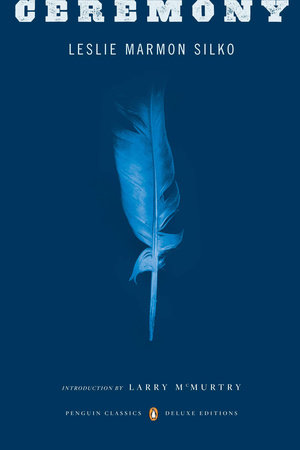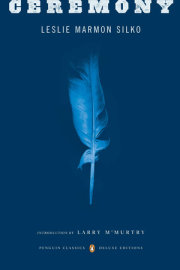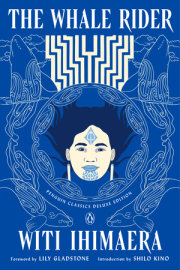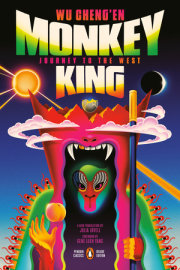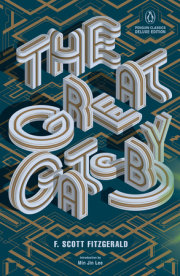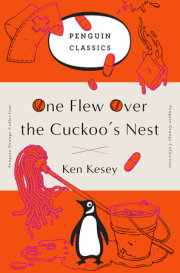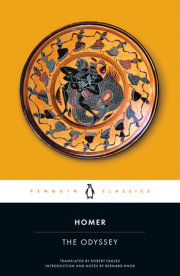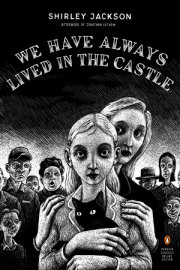Table of Contents
About the Author
Title Page
Copyright Page
Dedication
Preface
Introduction
Ceremony
Sunrise.
About the Author
LESLIE MARMON SILKO was born in Albuquerque in 1948 of mixed ancestry—Laguna Pueblo, Mexican, and white. She grew up in the Laguna Pueblo Reservation, where she lives with her husband and two children. She is the author of the novel Almanac of the Dead, and her stories have appeared in many magazines and collections (including Writers of the Purple Sage). She is the recipient of a five-year MacArthur Foundation grant.
LARRY McMURTRY is the author of twenty-eight novels, including the Pulitzer Prize-winning Lonesome Dove. His other works include two collections of essays, three memoirs, and more than thirty screenplays, including the coauthorship of Brokeback Mountain, for which he received an Academy Award. He lives in Archer City, Texas.
PENGUIN BOOKS
Published by the Penguin Group
Penguin Group (USA) Inc., 375 Hudson Street, New York, New York 10014, U.S.A.
Penguin Group (Canada), 90 Eglinton Avenue East, Suite 700, Toronto,
Ontario, Canada M4P 2Y3 (a division of Pearson Penguin Canada Inc.)
Penguin Books Ltd, 80 Strand, London WC2R 0RL, England
Penguin Ireland, 25 St Stephen’s Green, Dublin 2, Ireland (a division of Penguin Books Ltd)
Penguin Group (Australia), 250 Camberwell Road, Camberwell,
Victoria 3124, Australia (a division of Pearson Australia Group Pty Ltd)
Penguin Books India Pvt Ltd, 11 Community Centre, Panchsheel Park, New Delhi - 110 017, India
Penguin Group (NZ), cnr Airborne and Rosedale Roads, Albany,
Auckland 1310, New Zealand (a division of Pearson New Zealand Ltd)
Penguin Books (South Africa) (Pty) Ltd, 24 Sturdee Avenue,
Rosebank, Johannesburg 2196, South Africa
Penguin Books Ltd, Registered Offices:
80 Strand, London WC2R 0RL, England
First published in the United States of America by The Viking Press 1977
Published by New American Library 1978
Published in Penguin Books 1986
This edition with a preface by the author and an introduction by Larry McMurtry published 2006
Copyright © Leslie Marmon Silko, 1977, 2006
Introduction copyright © Larry McMurtry, 2006
All rights reserved
PUBLISHER’S NOTE
This is a work of fiction. Names, characters, places, and incidents either are the product
of the author’s imagination or are used fictitiously, and any resemblance to actual persons,
living or dead, business establishments, events, or locales is entirely coincidental.
THE LIBRARY OF CONGRESS CATALOGING-IN-PUBLICATION DATA
Silko, Leslie, 1943-
Ceremony / Leslie Marmon Silko ; introduction by Larry McMurtry.
p. cm.—(Penguin classics deluxe edition)
Originally published: New York : The Viking Press, 1977. With new preface by author.
ISBN: 9781440621826
1. World War, 1939-1945—Veterans—Fiction. 2. Laguna Indians—Fiction. I. Title.
PS3569.I44C4 2007
813'.54—dc22 2006050705
The scanning, uploading and distribution of this book via the Internet or via any other means without the permission of the publisher is illegal and punishable by law. Please purchase only authorized electronic editions, and do not participate in or encourage electronic piracy of copyrighted materials. Your support of the author’s rights is appreciated.
This book
is dedicated
to my grandmothers,
Jessie Goddard Leslie
and
Lillie Stagner Marmon,
and to my sons,
Robert William Chapman
and
Cazimir Silko
Thanks to the Rosewater Foundation-on-Ketchikan Creek,
Alaska, for the artist’s residence they generously provided.
Thanks also to the National Endowment for the Arts
and the 1974 Writing Fellowship.
John and Mei-Mei:
My love and my thanks to you
for keeping me going all the time.
Preface
We moved to Ketchikan, Alaska, from Chinle, Arizona, in the late spring of 1973. My elder son, Robert Chapman, was seven years old, and Cazimir was eighteen months. Ketchikan was John Silko’s hometown, and he’d taken a supervisory position in the legal services office in Ketchikan. I had a book contract with Viking Press because Richard Seaver, who was a Viking editor, saw my short stories in Ken Rosen’s anthology, The Man to Send Rain Clouds. At the time I thought it was odd that my book contract specified either a collection of short stories or a novel. I didn’t have a literary agent then to explain that publishers preferred novels. I had no intention of writing anything but short stories for Viking Press; I felt confident about the short story as a genre, but aside from being a voracious reader of novels from age ten, I neglected to take that course the English Department offered on The Novel. No way I was going to mess with success. Short stories, that’s what I’d write. I used my writer’s grant from the National Endowment for the Arts to pay for day care for Caz while Robert was in school.
Located on Revillagigedo Island, 750 miles north of Seattle, Ketchikan had a mild climate by Alaskan standards due in large part to a warm ocean current named the Japanese Current. The average year-round temperature was forty-eight degrees, and the average rainfall was 180 inches. In Chinle the annual rainfall was twelve inches in a good year. I was accustomed to the bright sunlight of the Southwest, where the weather permitted activity outdoors all year around. In southeastern Alaska the tall spruce trees, the heavy clouds, fogs and mist and the steep mountains enclosed the town. In the Southwest I was accustomed to gazing into distances of forty or fifty miles. I was accustomed to seeing the sky and the stars and moon.
The change in climate had a profound effect on me; I spent all of June, July, and August fighting off the terrible lethargy of a depression caused in large part by the absence of sunlight. I managed to write one short story during that time, about a woman who drowned herself; it wasn’t a good short story but a message to myself. In September after the boys were in day care and school, I tried to write at home but I found it difficult to concentrate: the dirty dishes and dirty laundry seemed to cry out for attention.
About this time Richard Whittaker came to my aid. Dick and his family lived across the street from my Silko in-laws. He practiced Indian law mostly for the local tribes, and he was a strong supporter of the Alaska Legal Services program, which employed my husband. Dick was a reader of novels and especially admired Kurt Vonnegut’s God Bless You, Mr. Rosewater. I talked about needing a place to write, and Dick Whittaker invited me to use the table and chair in his closet-sized law library. His law office was located on the second floor of the building that housed the offices of the legal services program. The building is still there overlooking Ketchikan Creek, next to the great Chief Johnson totem pole with Raven and Fog Woman at the corner of Mission Street and Stedman Street.
I worked on the library table with my Hermes portable typewriter and a fountain pen. Once I saw what I’d typed, I immediately edited with a fountain pen. Every day I read the previous day’s writing to get myself started again. Luckily I was in the early stages when I didn’t have much manuscript or many notes, because of course I could not leave my work spread out over the law library table: Dick Whittaker and his staff did need to use the law books from time to time. I wrote the short story “Lullaby” in the law library. I’d already started to write what would become Ceremony, but after I heard Nash and Ada Chakee were killed, I allowed myself to stray from the novel long enough to write the short story in their memory.
After about six months, the legal services offices were moved to larger offices downtown, and I followed. There was a tiny office space there, but without a door. Some of the early draft of Ceremony is written on the back side of discarded legal services letterhead. I managed there for a couple of months until Dick Whittaker told me he couldn’t find a renter for the office space vacated by legal services. Rent free, he gave me the exclusive use of the space complete with heat and lights and, best of all, no telephone.
There was an outer room that had been for reception, and the inner office that had windows that looked out on Raven and Fog Woman above Ketchikan Creek. The inner office had a chair and a wide, long built-in plywood work area shaped like a wing. The first thing I did was buy a can of Chinese red enamel and paint the plywood desk top. I brought an old percolator down to make hot water for instant coffee. Some days when I got to my office I didn’t feel like working on the novel so I wrote letters to the new friends I’d met at a writers conference in Stevens Point, Wisconsin, in June of 1973. Other days I’d scoot the Hermes and manuscript over and I’d stretch out on top of the work area for a nap.
My rule for myself was this: I had to stay in that room whether I wrote or not, and, finally, after I’d written letters to Mei-Mei Berssenbrugge or Lawson Inada, the poets who provided me with moral support, or taken a nap, I’d walk over to the window to look up at the big black raven carved above me on the top of the pole. A long way down the pole came Raven’s two raven helpers, Gitsanuk and Gitsaqeq, their raven beaks oddly hooked, melted from the fire’s heat the time they carried Raven’s gift of fire to human beings. Then came the figures of Raven and his wife, Fog Woman, who held two salmon by the tails. The beauty of the carved figures lifted my spirits and I’d finally break down my resistance, and start work on the novel.
At the time I didn’t know much about the Chief Johnson pole or the story of Raven and Fog Woman, but later I learned what an auspicious location my writing office had. The Chief Johnson pole was set in 1901 to celebrate the potlatch given by Chief Johnson for the Kadjuk Tlingits. The carved figures recalled Raven’s beloved wife, Fog Woman, who used Raven’s spruce root hat to create the first salmon. Soon the rivers and ocean were jammed with salmon, and suddenly Raven was rich. Once he was rich, he began to neglect Fog Woman, and one day he spoke abusively to her until she ran toward the beach where she turned into fog. Raven told himself it didn’t matter, but when he got home he found all the dried salmon he’d stored came to life again and swam out to sea and Raven was as poor as before. The figure of Fog Woman on the pole faces the ocean at the place the salmon enter the creek to spawn; Fog Woman’s gift of the salmon made the people of Ketchikan rich.
Lunchtime was easy. Mrs. Hirabayashi’s café was only a half block away, on the street across from the docks and the fishing fleet. Mrs. Hirabayashi and her mother ran the place. It had a long white marble counter with stools where the fishermen liked to sit. They grew aged poinsettias plants in the café front window. It might have been a soda fountain at one time. The Hirabayashis, like other Japanese Americans, were imprisoned in internment camps during the war, and it was Gordon Hirabayashi, Mrs. Hirabayashi’s son, who with others worked tirelessly to secure redress for the crime from the U.S. Congress.
Mrs. Hirabayashi welcomed all her customers with a joyous greeting, and her elderly mother working behind the stove smiled shyly and nodded. I always ordered the same thing: green tea and a bowl of pork noodles. Except for me and a few old Tlingit and Haida people, the Hirabayshis’ customers were fishermen in rubber boots and gray wool halibut jackets. Usually it was raining. My first October, in 1973, Ketchikan got 42.5 inches of rain in thirty-one days. So after my noodles and tea, I usually went straight back to my writing and worked until three, when it was time to fetch Caz from day care to be home when Robert returned from school.
If it wasn’t raining too hard, sometimes I wandered around downtown Ketchikan just looking at the fishing boats or giant cruise ships and the vast flotillas of spruce logs towed by tug-boats to the pulp mill. Big ravens cavorted on the docks in search of tidbits from the fishing boats, but most amazing to my eyes were the great bald eagles, a dozen or more, that lounged or played in the tops of tall spruce while they waited to dive into the water for salmon. After a while I realized that Raven and Eagle still owned the town; the old-time tribal people belonged to the clans of Killer Whale, Grizzly Bear, and Wolf. Humans belonged to Halibut and King Salmon and Steel Head Trout clans too; surrounded by ocean, rivers, creeks, and rainwater, the watery clans seemed a safer bet. The totern poles often had small wan faces of “drowned men” carved between the major figures—I couldn’t swim and boats made me seasick—the small wan face might be me.
Once I started writing the novel, the depression lifted, but then came the terrible migraine headaches, worse than any I’d had since the tenth grade. I stayed in a darkened bedroom for eight hours at a time while the vertigo spun the bed. Fortunately, as the main character, Tayo, began to recover from his illness, I too began to feel better, and had fewer headaches. By this time, the novel was my refuge, my magic vehicle back to the Southwest land of sandstone mesas, blue sky, and sun. As I described the sandstone spring, the spiders, water bugs, swallows, and rattlesnakes, I remade the place in words; I was no longer on a dark rainy island thousands of miles away. I was home, from time immemorial, as the old ones liked to say to us children long ago.
I wasn’t just homesick for the sandstone cliffs and the sun; I missed the people and the storytelling, so I incorporated into the novel the old-time story about Hummingbird and Green Fly, who help the people purify their town to bring back the Corn Mother. The title of the novel, Ceremony, refers to the healing ceremonies based on the ancient stories of the Diné and Pueblo people. The two years I lived and taught for Diné College were important to my understanding of the healing ceremony’s relationship to storytelling. I was conscious of constructing the novel out of many different kinds of narratives or stories to celebrate storytelling with the spoken as well as the written word. I indulged myself with the old-time stories because they evoked a feeling of comfort I remembered from my childhood at Laguna.
During this time the wet climate did not agree with my younger son, Cazimir, who was twice hospitalized for acute asthma. Grandma Lillie, on a visit to Ketchikan, suffered a heart attack. At crisis times I completely forgot the novel, but afterward the need to return to the work became overwhelming. The novel was my escape, and I remember how I fretted on weekends because I was so anxious to keep working. I wasn’t sure what I was writing qualified as a “novel.”
It was supposed to be a funny story about Harley, the World War II veteran whose family tried but could not keep him away from liquor. But as I wrote about Harley’s desperate thirst for alcohol, it didn’t seem so funny after all, and I realized I wanted to better understand what happened to the war veterans, many of whom were survivors of the Battan Death March, cousins and relatives of mine who returned from the war and stayed drunk the rest of their lives. The war veterans weren’t always drunk, and they were home and available to us children when the other adults were busy at work. These men were kind to us children; they helped me train with my first horse. Even as a child I knew they were not bad people, yet something had happened to them. What was it?
As I wrote what I thought would be a comical short story about Harley and his drunken exploits, suddenly a friend of Harley’s—a character I never planned to have—Tayo, entered the story. I was perturbed because Tayo’s condition didn’t promise much comedy. Before I began the funny story about Harley, I twice tried to develop a young female protagonist to be the main character of a novel; but I found I was too self-conscious and failed to allow my fictional woman to behave independently of my image of myself. The notes and false starts and the short story beginnings that developed into Ceremony are in the collection of the Yale University library.
In February 1974, I interrupted work on the novel to go to Bethel, Alaska, for three weeks to be a visiting writer in the middle school. Eighty miles from the Bering Sea and with temperatures of fifty below zero, I still found Bethel preferable to Ketchikan because at least the frozen tundra had blue sky and miles of visibility in all directions. I remember the day I had lunch with my friend Rose Prince in Bethel and told her and her friend about my idea to have all things European invented by a tribal witch. I made notes then, but didn’t actually write the creation of the witchery section until June 1974 while I was at the Grand State College Writers Conference. I wrote it a few hours before my reading that night. That was the night I first met the poet James A. Wright. I was in a group of ten or twelve young poets that included Mei-Mei Berssenbrugge and Lawson Inada when we were introduced. Wright’s poetry had a profound effect on the work of all of us at the conference. He wrote to me after Ceremony was published, and we engaged in a wonderful correspondence that I cherish with the friendship we shared.
After I returned to Ketchikan from Bethel I stopped work on the novel long enough to write the short story “Storyteller.” Although I was only in Bethel for a month, the stories I heard while I was there, stories about the tundra and the Yupik people, left a powerful impression on me, and the stories I heard there refused to let me get back to work on Ceremony until I wrote a short story about the place and people of the Bethel area.
As I neared the end of the novel, I knew what I had to write; all that remained was to do it. I remember typing that last word, “Sunrise,” and feeling great relief and happiness that the novel and “the ceremony” were finished. I fussed around with the ending a bit more, but the manuscript was completed during the first week of July 1975, eight weeks before we left Ketchikan to move back to New Mexico.
I sent off two copies of the manuscript: one to Richard Seaver at Viking Press, and the other to Mei-Mei Berssenbruge, the poet. I still wasn’t quite sure if it was a novel, so I waited anxiously to hear from them. Mei-Mei called right away and was very excited. She said she especially liked the way I did not break the novel into chapters. “Oh no!” I thought while she was talking, “I knew I forgot something!” (I never should have neglected that course titled The Novel.) “Don’t worry,” I told myself, “you can call Seaver and tell him you’ll send a revised copy with the chapters, and you can do it in a day or two, easily.” But later, as I worked to break the novel into chapters, I realized it was not meant to be in chapters, so I left it as it was.
Richard Seaver called a few days later and expressed his satisfaction with the novel. He wanted to make only one editorial change. Instead of the more proper “as if,” I’d used the colloquial “like”—e.g., “He ran like a dog” vs. “He ran as if he were a dog.” I checked a dictionary and found that Norman Mailer was allowed to use “like” in his novels, so I initially refused to make the changes. I didn’t have an agent then, so when Dick Seaver hinted that if I didn’t take the editorial advice on this point, he and Jeanette Seaver “could not get behind the book,” I decided to agree to the change, in part because there were only about six instances where I used “like” instead of “as if.”
Jeanette Seaver was my editor during the production phase, and she managed to get the art department to use my father’s photograph of Mt. Taylor and old Acoma pueblo for the cover of the book jacket. Mt. Taylor, or Tśepina, is a sacred mountain central to much of the novel.
Ceremony was published in March 1977. The Seavers gave me a wonderful cocktail party at their Central Park West home. I was staying downtown on Water Street near Wall Street, and when it was time for me to find a cab to take me uptown, no one had warned me there were hundreds of cabs but none for hire because the Wall Street people had all the cabs under contract. So I had to walk in my party dress and high heel shoes to find a subway, and then I took the wrong line and had to walk a distance to Central Park West. When I arrived I was late and I was sweaty and my hair was messy; fortunately, the others had consumed enough wine by then and didn’t care.
Gus Blaisdel gave me a publication party at his bookstore, The Living Batch, in Albuquerque, where I was teaching at the University of New Mexico. No book tour for a first novel, but Geraldo Rivera and Good Morning America did a short piece on the novel at Marlon Brando’s suggestion. Brando read Ceremony , and later when I worked on a film project for him, he sometimes brought up obscure details from Ceremony that I hardly remembered; he had a photographic memory for anything he saw or read.
After Ceremony was published, some readers remarked on my male protagonist and many male characters, something of a novelty for female novelists in the English language. My childhood was spent in the Pueblo matriarchy, where women owned property, and children belonged to the mother’s clan. The story of the returning World War II veterans could only be told from a male point of view, so I did it without hesitation. Besides, I thought, male novelists write about female protagonists all the time, so I will write about men.
In this and in all things related to the writing of Ceremony, I feel I was blessed, watched over, and protected by my beloved ancestors, and the old ones who told me the stories—Grandma A’mooh, Aunt Susie, and Grandpa Hank. May the readers and listeners of this novel be likewise blessed, watched over, and protected by their beloved ancestors.
—LESLIE MARMON SILKO
Introduction
When Leslie Marmon Silko began to publish her first stories and poems in the early 1970s, it was immediately clear to discerning judges that a literary star of unusual brilliance had appeared. Among the discerning judges were the selectors for the MacArthur Foundation in Chicago, who chose Leslie Marmon Silko as one of their very first group of fellows, to receive what is now known as a “genius” award.
. All rights reserved. No part of this excerpt may be reproduced or reprinted without permission in writing from the publisher.

